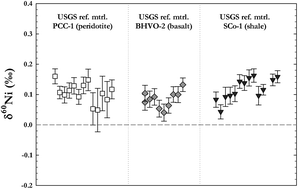We present a new technique for the accurate and precise determination of mass-dependent variations in nickel isotope compositions in geological materials. Our method involves an ion-exchange procedure comprising three columns and utilising the ability of Ni to form strong complexes with both ammonia and dimethylglyoxime. The separation procedure is independent of sample pH and works even for samples with large matrix to analyte ratios. Processed Ni solutions are free of matrix elements and direct isobars of Ni, and the yield is normally 85–95%. The purified Ni solutions were analysed using a Nu Plasma, multi-collector inductively coupled plasma mass spectrometer (MC-ICPMS), where instrumental mass fractionation—together with potential isotopic fractionation during chemical separation due to incomplete yield—was corrected for by a double-spike technique, where samples were spiked prior to column chemistry. Tests performed on both mixtures of synthetic and natural terrestrial standards demonstrates that the method is accurate. Replicate measurements of USGS reference materials (peridotite PCC-1, basalt BHVO-2, and shale SCo-1) yield a long-term external reproducibility (2 s.d.) of typically ± 0.07‰, ± 0.1‰, and ± 0.14‰ for 60Ni/58Ni, 61Ni/58Ni, and 62Ni/58Ni respectively.

You have access to this article
 Please wait while we load your content...
Something went wrong. Try again?
Please wait while we load your content...
Something went wrong. Try again?


 Please wait while we load your content...
Please wait while we load your content...